Assessing the Impact of Employee Partnership at John Lewis
VerifiedAdded on 2020/07/22
|30
|9117
|167
Project
AI Summary
This project assesses the impact of the employee partnership model on the long-term success of John Lewis. It utilizes a descriptive research design, incorporating both qualitative and quantitative techniques. The study examines employee satisfaction, organizational growth, and the challenges associated with the partnership model. The research includes an overview of the company, research problems, aims, objectives, and research questions. A comprehensive literature review explores the importance of the partnership model in boosting employee morale, its relationship to organizational growth, and its impact on organizations. The methodology section details the research approach, philosophy, data collection methods, sampling techniques, and data analysis. Findings from the data analysis are presented, followed by conclusions, recommendations, and a discussion based on the research. The project aims to understand how the partnership model influences employee morale, organizational growth, and overall success, providing insights and recommendations for improvements.

PROJECT
Paraphrase This Document
Need a fresh take? Get an instant paraphrase of this document with our AI Paraphraser

ABSTRACT
The aim of the study is to assess the impact of employee’s partnership model on the long-term
success of John Lewis. The descriptive research design is used in the present research. It assists
in providing detail information on the selected topic. Both qualitative and quantitative techniques
are used for the current study. From the above data analysis, it is identified that employees are
highly satisfied with their job as it is their hobby. It is essential for the company to increase the
satisfaction level of customers so that they work hard within the organisation and love their job.
From the secondary research, it is analysed that employee partnership model helps company in
increasing the sense of confidence in employees where it is with a special reference to those
enterprises that focus on adopting a partnership approach.
The aim of the study is to assess the impact of employee’s partnership model on the long-term
success of John Lewis. The descriptive research design is used in the present research. It assists
in providing detail information on the selected topic. Both qualitative and quantitative techniques
are used for the current study. From the above data analysis, it is identified that employees are
highly satisfied with their job as it is their hobby. It is essential for the company to increase the
satisfaction level of customers so that they work hard within the organisation and love their job.
From the secondary research, it is analysed that employee partnership model helps company in
increasing the sense of confidence in employees where it is with a special reference to those
enterprises that focus on adopting a partnership approach.
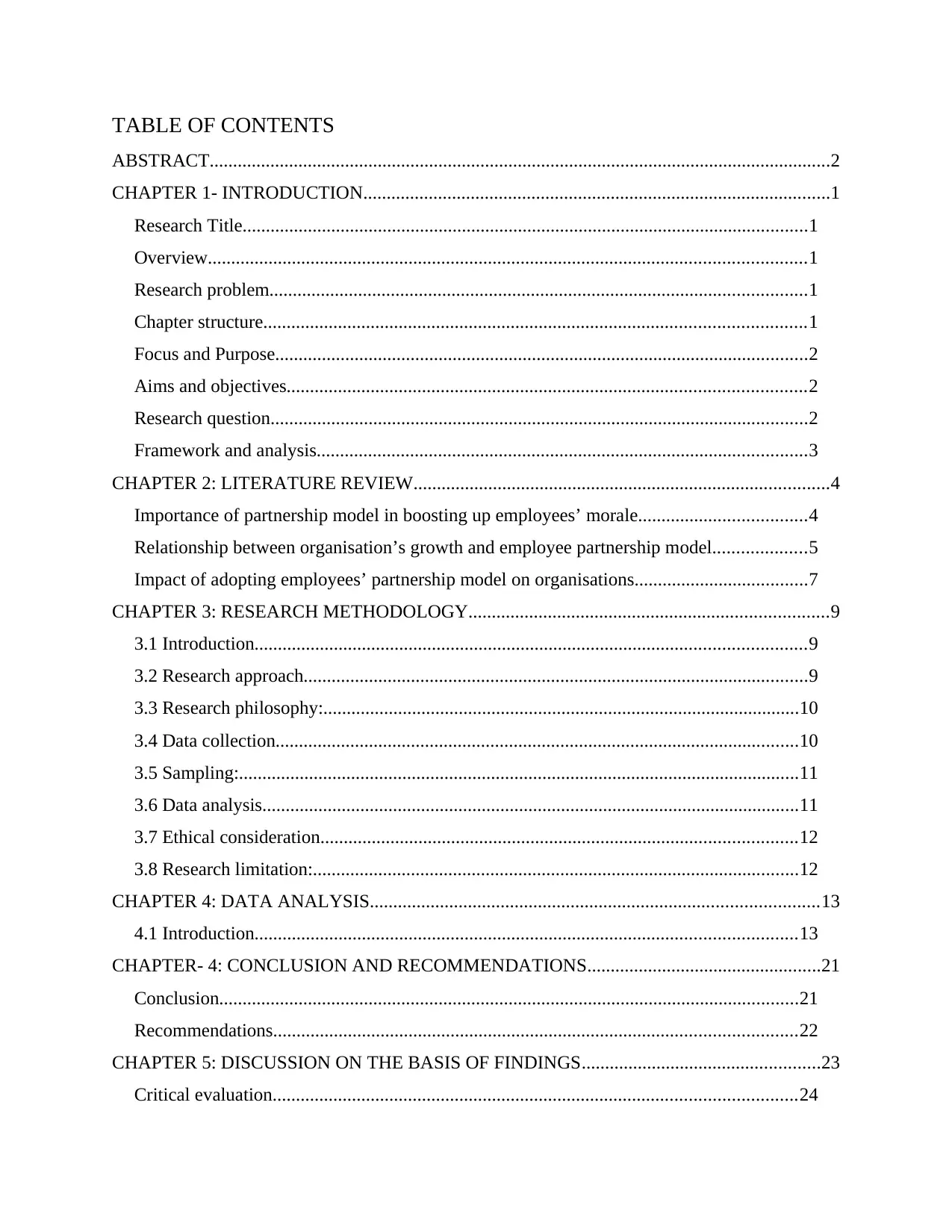
TABLE OF CONTENTS
ABSTRACT.....................................................................................................................................2
CHAPTER 1- INTRODUCTION....................................................................................................1
Research Title.........................................................................................................................1
Overview................................................................................................................................1
Research problem...................................................................................................................1
Chapter structure....................................................................................................................1
Focus and Purpose..................................................................................................................2
Aims and objectives...............................................................................................................2
Research question...................................................................................................................2
Framework and analysis.........................................................................................................3
CHAPTER 2: LITERATURE REVIEW.........................................................................................4
Importance of partnership model in boosting up employees’ morale....................................4
Relationship between organisation’s growth and employee partnership model....................5
Impact of adopting employees’ partnership model on organisations.....................................7
CHAPTER 3: RESEARCH METHODOLOGY.............................................................................9
3.1 Introduction......................................................................................................................9
3.2 Research approach............................................................................................................9
3.3 Research philosophy:......................................................................................................10
3.4 Data collection................................................................................................................10
3.5 Sampling:........................................................................................................................11
3.6 Data analysis...................................................................................................................11
3.7 Ethical consideration......................................................................................................12
3.8 Research limitation:........................................................................................................12
CHAPTER 4: DATA ANALYSIS................................................................................................13
4.1 Introduction....................................................................................................................13
CHAPTER- 4: CONCLUSION AND RECOMMENDATIONS..................................................21
Conclusion............................................................................................................................21
Recommendations................................................................................................................22
CHAPTER 5: DISCUSSION ON THE BASIS OF FINDINGS...................................................23
Critical evaluation................................................................................................................24
ABSTRACT.....................................................................................................................................2
CHAPTER 1- INTRODUCTION....................................................................................................1
Research Title.........................................................................................................................1
Overview................................................................................................................................1
Research problem...................................................................................................................1
Chapter structure....................................................................................................................1
Focus and Purpose..................................................................................................................2
Aims and objectives...............................................................................................................2
Research question...................................................................................................................2
Framework and analysis.........................................................................................................3
CHAPTER 2: LITERATURE REVIEW.........................................................................................4
Importance of partnership model in boosting up employees’ morale....................................4
Relationship between organisation’s growth and employee partnership model....................5
Impact of adopting employees’ partnership model on organisations.....................................7
CHAPTER 3: RESEARCH METHODOLOGY.............................................................................9
3.1 Introduction......................................................................................................................9
3.2 Research approach............................................................................................................9
3.3 Research philosophy:......................................................................................................10
3.4 Data collection................................................................................................................10
3.5 Sampling:........................................................................................................................11
3.6 Data analysis...................................................................................................................11
3.7 Ethical consideration......................................................................................................12
3.8 Research limitation:........................................................................................................12
CHAPTER 4: DATA ANALYSIS................................................................................................13
4.1 Introduction....................................................................................................................13
CHAPTER- 4: CONCLUSION AND RECOMMENDATIONS..................................................21
Conclusion............................................................................................................................21
Recommendations................................................................................................................22
CHAPTER 5: DISCUSSION ON THE BASIS OF FINDINGS...................................................23
Critical evaluation................................................................................................................24
⊘ This is a preview!⊘
Do you want full access?
Subscribe today to unlock all pages.

Trusted by 1+ million students worldwide

REFERENCES..............................................................................................................................25
Paraphrase This Document
Need a fresh take? Get an instant paraphrase of this document with our AI Paraphraser
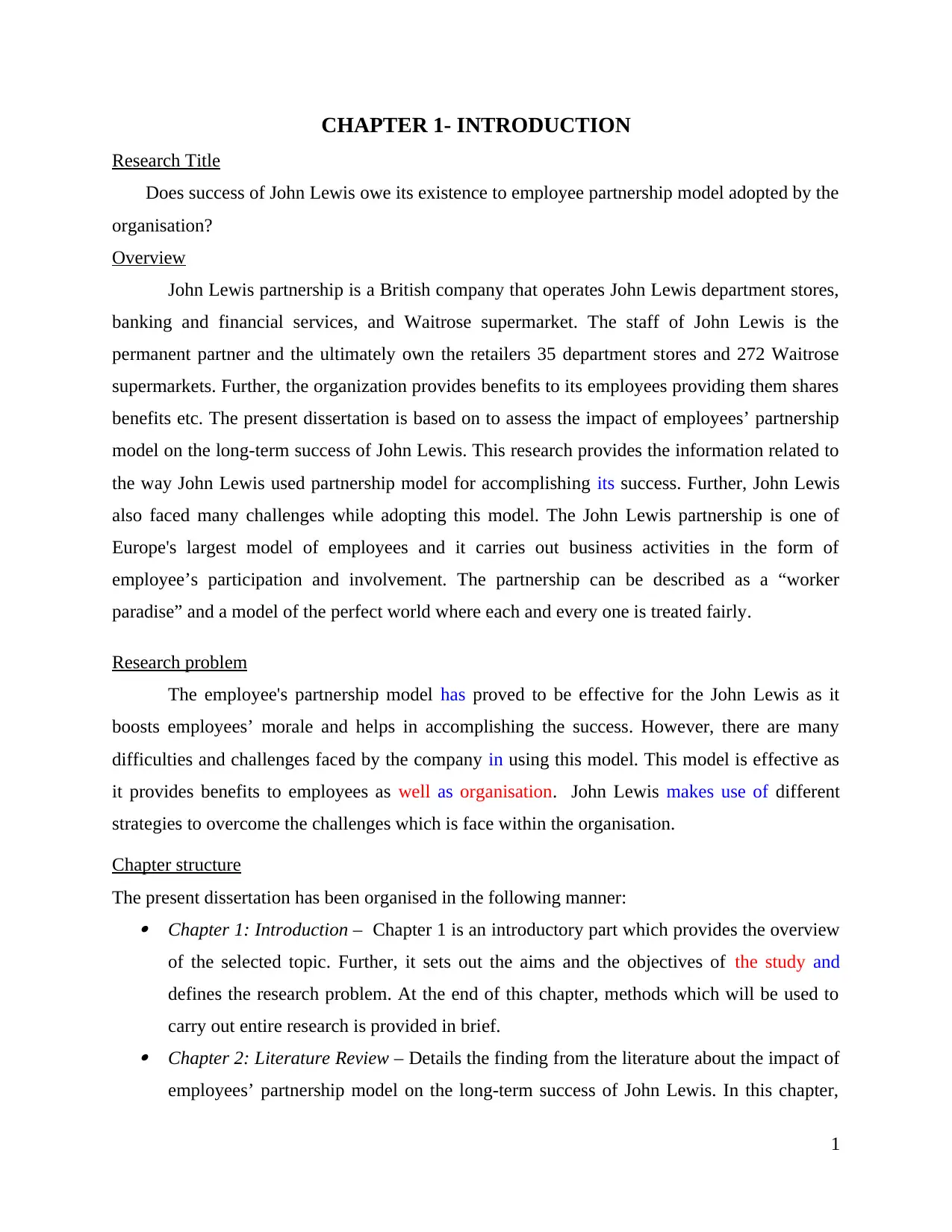
CHAPTER 1- INTRODUCTION
Research Title
Does success of John Lewis owe its existence to employee partnership model adopted by the
organisation?
Overview
John Lewis partnership is a British company that operates John Lewis department stores,
banking and financial services, and Waitrose supermarket. The staff of John Lewis is the
permanent partner and the ultimately own the retailers 35 department stores and 272 Waitrose
supermarkets. Further, the organization provides benefits to its employees providing them shares
benefits etc. The present dissertation is based on to assess the impact of employees’ partnership
model on the long-term success of John Lewis. This research provides the information related to
the way John Lewis used partnership model for accomplishing its success. Further, John Lewis
also faced many challenges while adopting this model. The John Lewis partnership is one of
Europe's largest model of employees and it carries out business activities in the form of
employee’s participation and involvement. The partnership can be described as a “worker
paradise” and a model of the perfect world where each and every one is treated fairly.
Research problem
The employee's partnership model has proved to be effective for the John Lewis as it
boosts employees’ morale and helps in accomplishing the success. However, there are many
difficulties and challenges faced by the company in using this model. This model is effective as
it provides benefits to employees as well as organisation. John Lewis makes use of different
strategies to overcome the challenges which is face within the organisation.
Chapter structure
The present dissertation has been organised in the following manner: Chapter 1: Introduction – Chapter 1 is an introductory part which provides the overview
of the selected topic. Further, it sets out the aims and the objectives of the study and
defines the research problem. At the end of this chapter, methods which will be used to
carry out entire research is provided in brief. Chapter 2: Literature Review – Details the finding from the literature about the impact of
employees’ partnership model on the long-term success of John Lewis. In this chapter,
1
Research Title
Does success of John Lewis owe its existence to employee partnership model adopted by the
organisation?
Overview
John Lewis partnership is a British company that operates John Lewis department stores,
banking and financial services, and Waitrose supermarket. The staff of John Lewis is the
permanent partner and the ultimately own the retailers 35 department stores and 272 Waitrose
supermarkets. Further, the organization provides benefits to its employees providing them shares
benefits etc. The present dissertation is based on to assess the impact of employees’ partnership
model on the long-term success of John Lewis. This research provides the information related to
the way John Lewis used partnership model for accomplishing its success. Further, John Lewis
also faced many challenges while adopting this model. The John Lewis partnership is one of
Europe's largest model of employees and it carries out business activities in the form of
employee’s participation and involvement. The partnership can be described as a “worker
paradise” and a model of the perfect world where each and every one is treated fairly.
Research problem
The employee's partnership model has proved to be effective for the John Lewis as it
boosts employees’ morale and helps in accomplishing the success. However, there are many
difficulties and challenges faced by the company in using this model. This model is effective as
it provides benefits to employees as well as organisation. John Lewis makes use of different
strategies to overcome the challenges which is face within the organisation.
Chapter structure
The present dissertation has been organised in the following manner: Chapter 1: Introduction – Chapter 1 is an introductory part which provides the overview
of the selected topic. Further, it sets out the aims and the objectives of the study and
defines the research problem. At the end of this chapter, methods which will be used to
carry out entire research is provided in brief. Chapter 2: Literature Review – Details the finding from the literature about the impact of
employees’ partnership model on the long-term success of John Lewis. In this chapter,
1
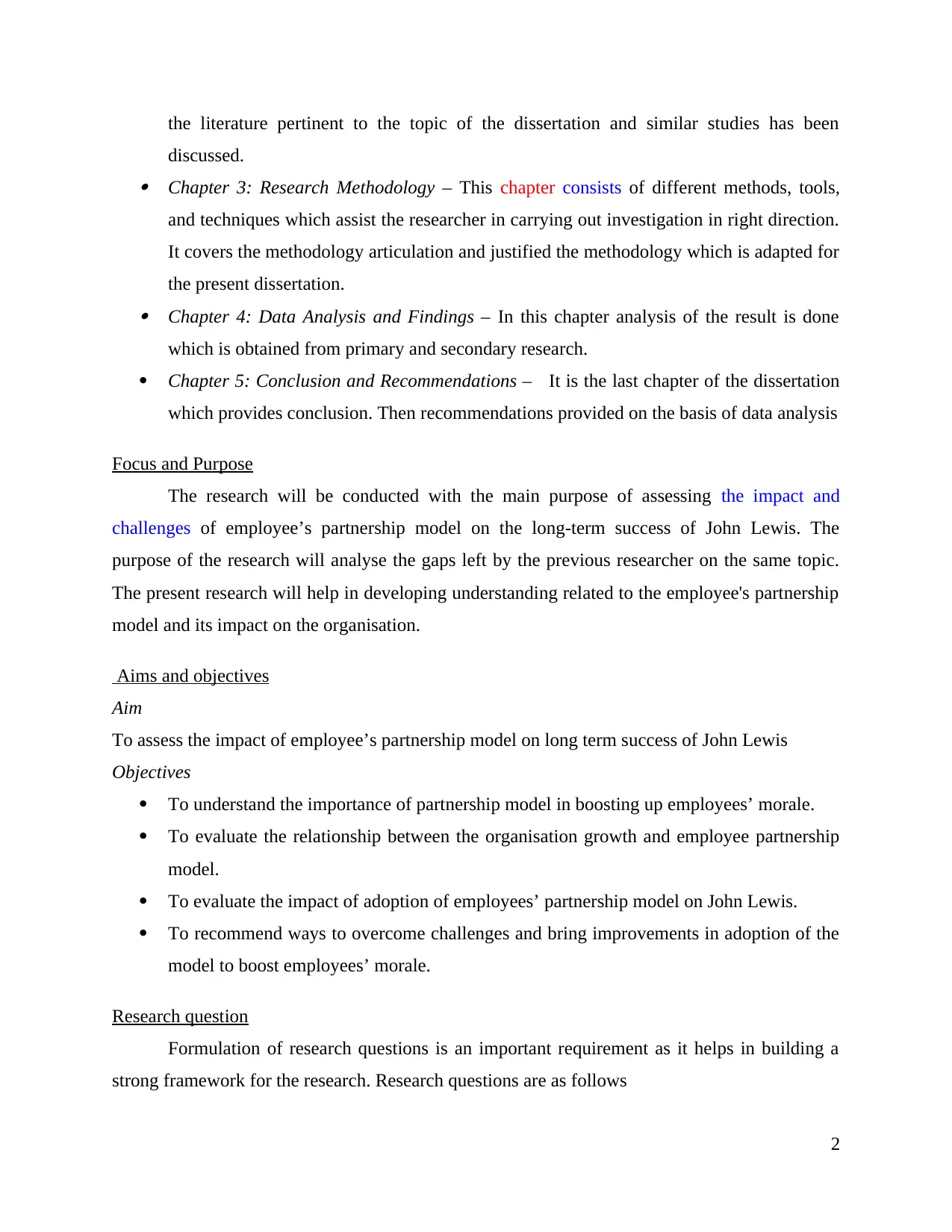
the literature pertinent to the topic of the dissertation and similar studies has been
discussed. Chapter 3: Research Methodology – This chapter consists of different methods, tools,
and techniques which assist the researcher in carrying out investigation in right direction.
It covers the methodology articulation and justified the methodology which is adapted for
the present dissertation. Chapter 4: Data Analysis and Findings – In this chapter analysis of the result is done
which is obtained from primary and secondary research.
Chapter 5: Conclusion and Recommendations – It is the last chapter of the dissertation
which provides conclusion. Then recommendations provided on the basis of data analysis
Focus and Purpose
The research will be conducted with the main purpose of assessing the impact and
challenges of employee’s partnership model on the long-term success of John Lewis. The
purpose of the research will analyse the gaps left by the previous researcher on the same topic.
The present research will help in developing understanding related to the employee's partnership
model and its impact on the organisation.
Aims and objectives
Aim
To assess the impact of employee’s partnership model on long term success of John Lewis
Objectives
To understand the importance of partnership model in boosting up employees’ morale.
To evaluate the relationship between the organisation growth and employee partnership
model.
To evaluate the impact of adoption of employees’ partnership model on John Lewis.
To recommend ways to overcome challenges and bring improvements in adoption of the
model to boost employees’ morale.
Research question
Formulation of research questions is an important requirement as it helps in building a
strong framework for the research. Research questions are as follows
2
discussed. Chapter 3: Research Methodology – This chapter consists of different methods, tools,
and techniques which assist the researcher in carrying out investigation in right direction.
It covers the methodology articulation and justified the methodology which is adapted for
the present dissertation. Chapter 4: Data Analysis and Findings – In this chapter analysis of the result is done
which is obtained from primary and secondary research.
Chapter 5: Conclusion and Recommendations – It is the last chapter of the dissertation
which provides conclusion. Then recommendations provided on the basis of data analysis
Focus and Purpose
The research will be conducted with the main purpose of assessing the impact and
challenges of employee’s partnership model on the long-term success of John Lewis. The
purpose of the research will analyse the gaps left by the previous researcher on the same topic.
The present research will help in developing understanding related to the employee's partnership
model and its impact on the organisation.
Aims and objectives
Aim
To assess the impact of employee’s partnership model on long term success of John Lewis
Objectives
To understand the importance of partnership model in boosting up employees’ morale.
To evaluate the relationship between the organisation growth and employee partnership
model.
To evaluate the impact of adoption of employees’ partnership model on John Lewis.
To recommend ways to overcome challenges and bring improvements in adoption of the
model to boost employees’ morale.
Research question
Formulation of research questions is an important requirement as it helps in building a
strong framework for the research. Research questions are as follows
2
⊘ This is a preview!⊘
Do you want full access?
Subscribe today to unlock all pages.

Trusted by 1+ million students worldwide

How does partnership model boost up employees’ morale in John Lewis?
What is the relationship between the organisation growth and employee partnership
model.
How does growth of John Lewis dependent on its move to adopt employees’ partnership
model?
What is the impact of adoption of employees’ partnership model on John Lewis.
Framework and analysis Design of research– Descriptive research design will be used in the present research. It
assists in providing detail information on the selected topic. Research approach – In the present dissertation inductive approach will be used for
moving from specific content to general. Research philosophy – Interpretivism philosophy will be applied in the present
dissertation Techniques of research – Both qualitative and quantitative techniques will be used for
the current study. Method for data collection – Both primary and secondary method will be used for
collection the information. In primary survey will be conducted while in secondary
books, internet and websites will be used for collection of data.
Sampling technique –
Analysis of data – All the collected information will be analysed with the use of
quantitative method. There different test will be applied for getting appropriate result.
3
What is the relationship between the organisation growth and employee partnership
model.
How does growth of John Lewis dependent on its move to adopt employees’ partnership
model?
What is the impact of adoption of employees’ partnership model on John Lewis.
Framework and analysis Design of research– Descriptive research design will be used in the present research. It
assists in providing detail information on the selected topic. Research approach – In the present dissertation inductive approach will be used for
moving from specific content to general. Research philosophy – Interpretivism philosophy will be applied in the present
dissertation Techniques of research – Both qualitative and quantitative techniques will be used for
the current study. Method for data collection – Both primary and secondary method will be used for
collection the information. In primary survey will be conducted while in secondary
books, internet and websites will be used for collection of data.
Sampling technique –
Analysis of data – All the collected information will be analysed with the use of
quantitative method. There different test will be applied for getting appropriate result.
3
Paraphrase This Document
Need a fresh take? Get an instant paraphrase of this document with our AI Paraphraser
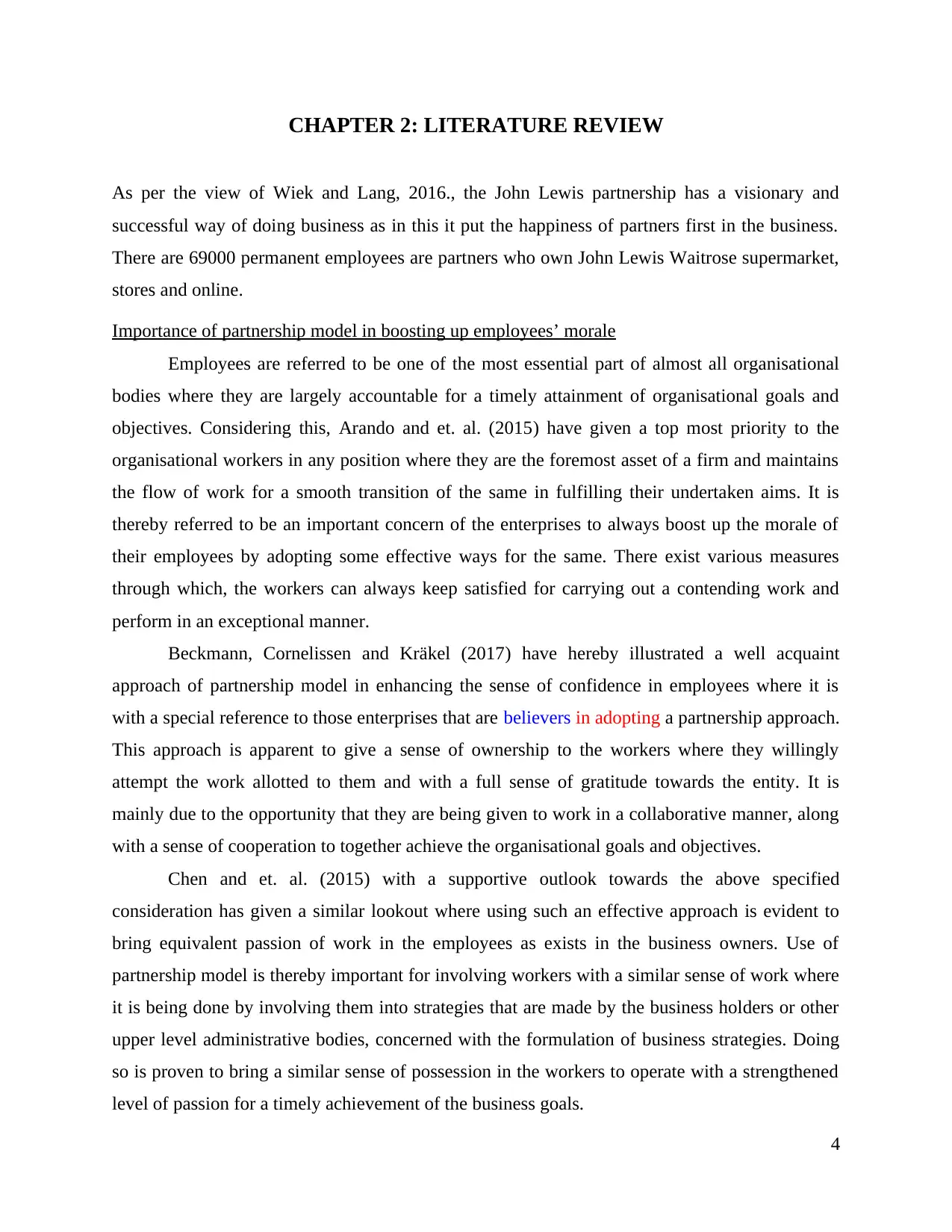
CHAPTER 2: LITERATURE REVIEW
As per the view of Wiek and Lang, 2016., the John Lewis partnership has a visionary and
successful way of doing business as in this it put the happiness of partners first in the business.
There are 69000 permanent employees are partners who own John Lewis Waitrose supermarket,
stores and online.
Importance of partnership model in boosting up employees’ morale
Employees are referred to be one of the most essential part of almost all organisational
bodies where they are largely accountable for a timely attainment of organisational goals and
objectives. Considering this, Arando and et. al. (2015) have given a top most priority to the
organisational workers in any position where they are the foremost asset of a firm and maintains
the flow of work for a smooth transition of the same in fulfilling their undertaken aims. It is
thereby referred to be an important concern of the enterprises to always boost up the morale of
their employees by adopting some effective ways for the same. There exist various measures
through which, the workers can always keep satisfied for carrying out a contending work and
perform in an exceptional manner.
Beckmann, Cornelissen and Kräkel (2017) have hereby illustrated a well acquaint
approach of partnership model in enhancing the sense of confidence in employees where it is
with a special reference to those enterprises that are believers in adopting a partnership approach.
This approach is apparent to give a sense of ownership to the workers where they willingly
attempt the work allotted to them and with a full sense of gratitude towards the entity. It is
mainly due to the opportunity that they are being given to work in a collaborative manner, along
with a sense of cooperation to together achieve the organisational goals and objectives.
Chen and et. al. (2015) with a supportive outlook towards the above specified
consideration has given a similar lookout where using such an effective approach is evident to
bring equivalent passion of work in the employees as exists in the business owners. Use of
partnership model is thereby important for involving workers with a similar sense of work where
it is being done by involving them into strategies that are made by the business holders or other
upper level administrative bodies, concerned with the formulation of business strategies. Doing
so is proven to bring a similar sense of possession in the workers to operate with a strengthened
level of passion for a timely achievement of the business goals.
4
As per the view of Wiek and Lang, 2016., the John Lewis partnership has a visionary and
successful way of doing business as in this it put the happiness of partners first in the business.
There are 69000 permanent employees are partners who own John Lewis Waitrose supermarket,
stores and online.
Importance of partnership model in boosting up employees’ morale
Employees are referred to be one of the most essential part of almost all organisational
bodies where they are largely accountable for a timely attainment of organisational goals and
objectives. Considering this, Arando and et. al. (2015) have given a top most priority to the
organisational workers in any position where they are the foremost asset of a firm and maintains
the flow of work for a smooth transition of the same in fulfilling their undertaken aims. It is
thereby referred to be an important concern of the enterprises to always boost up the morale of
their employees by adopting some effective ways for the same. There exist various measures
through which, the workers can always keep satisfied for carrying out a contending work and
perform in an exceptional manner.
Beckmann, Cornelissen and Kräkel (2017) have hereby illustrated a well acquaint
approach of partnership model in enhancing the sense of confidence in employees where it is
with a special reference to those enterprises that are believers in adopting a partnership approach.
This approach is apparent to give a sense of ownership to the workers where they willingly
attempt the work allotted to them and with a full sense of gratitude towards the entity. It is
mainly due to the opportunity that they are being given to work in a collaborative manner, along
with a sense of cooperation to together achieve the organisational goals and objectives.
Chen and et. al. (2015) with a supportive outlook towards the above specified
consideration has given a similar lookout where using such an effective approach is evident to
bring equivalent passion of work in the employees as exists in the business owners. Use of
partnership model is thereby important for involving workers with a similar sense of work where
it is being done by involving them into strategies that are made by the business holders or other
upper level administrative bodies, concerned with the formulation of business strategies. Doing
so is proven to bring a similar sense of possession in the workers to operate with a strengthened
level of passion for a timely achievement of the business goals.
4
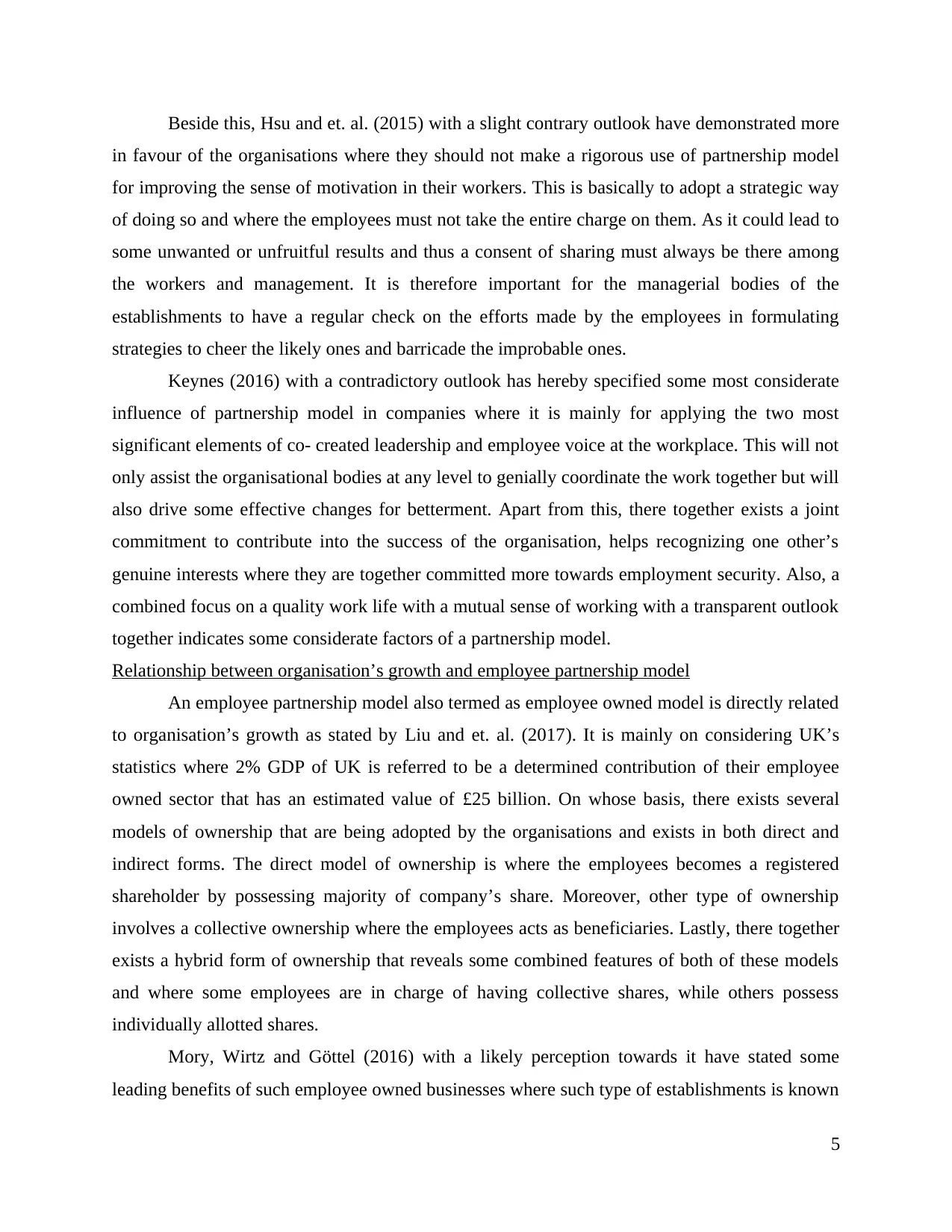
Beside this, Hsu and et. al. (2015) with a slight contrary outlook have demonstrated more
in favour of the organisations where they should not make a rigorous use of partnership model
for improving the sense of motivation in their workers. This is basically to adopt a strategic way
of doing so and where the employees must not take the entire charge on them. As it could lead to
some unwanted or unfruitful results and thus a consent of sharing must always be there among
the workers and management. It is therefore important for the managerial bodies of the
establishments to have a regular check on the efforts made by the employees in formulating
strategies to cheer the likely ones and barricade the improbable ones.
Keynes (2016) with a contradictory outlook has hereby specified some most considerate
influence of partnership model in companies where it is mainly for applying the two most
significant elements of co- created leadership and employee voice at the workplace. This will not
only assist the organisational bodies at any level to genially coordinate the work together but will
also drive some effective changes for betterment. Apart from this, there together exists a joint
commitment to contribute into the success of the organisation, helps recognizing one other’s
genuine interests where they are together committed more towards employment security. Also, a
combined focus on a quality work life with a mutual sense of working with a transparent outlook
together indicates some considerate factors of a partnership model.
Relationship between organisation’s growth and employee partnership model
An employee partnership model also termed as employee owned model is directly related
to organisation’s growth as stated by Liu and et. al. (2017). It is mainly on considering UK’s
statistics where 2% GDP of UK is referred to be a determined contribution of their employee
owned sector that has an estimated value of £25 billion. On whose basis, there exists several
models of ownership that are being adopted by the organisations and exists in both direct and
indirect forms. The direct model of ownership is where the employees becomes a registered
shareholder by possessing majority of company’s share. Moreover, other type of ownership
involves a collective ownership where the employees acts as beneficiaries. Lastly, there together
exists a hybrid form of ownership that reveals some combined features of both of these models
and where some employees are in charge of having collective shares, while others possess
individually allotted shares.
Mory, Wirtz and Göttel (2016) with a likely perception towards it have stated some
leading benefits of such employee owned businesses where such type of establishments is known
5
in favour of the organisations where they should not make a rigorous use of partnership model
for improving the sense of motivation in their workers. This is basically to adopt a strategic way
of doing so and where the employees must not take the entire charge on them. As it could lead to
some unwanted or unfruitful results and thus a consent of sharing must always be there among
the workers and management. It is therefore important for the managerial bodies of the
establishments to have a regular check on the efforts made by the employees in formulating
strategies to cheer the likely ones and barricade the improbable ones.
Keynes (2016) with a contradictory outlook has hereby specified some most considerate
influence of partnership model in companies where it is mainly for applying the two most
significant elements of co- created leadership and employee voice at the workplace. This will not
only assist the organisational bodies at any level to genially coordinate the work together but will
also drive some effective changes for betterment. Apart from this, there together exists a joint
commitment to contribute into the success of the organisation, helps recognizing one other’s
genuine interests where they are together committed more towards employment security. Also, a
combined focus on a quality work life with a mutual sense of working with a transparent outlook
together indicates some considerate factors of a partnership model.
Relationship between organisation’s growth and employee partnership model
An employee partnership model also termed as employee owned model is directly related
to organisation’s growth as stated by Liu and et. al. (2017). It is mainly on considering UK’s
statistics where 2% GDP of UK is referred to be a determined contribution of their employee
owned sector that has an estimated value of £25 billion. On whose basis, there exists several
models of ownership that are being adopted by the organisations and exists in both direct and
indirect forms. The direct model of ownership is where the employees becomes a registered
shareholder by possessing majority of company’s share. Moreover, other type of ownership
involves a collective ownership where the employees acts as beneficiaries. Lastly, there together
exists a hybrid form of ownership that reveals some combined features of both of these models
and where some employees are in charge of having collective shares, while others possess
individually allotted shares.
Mory, Wirtz and Göttel (2016) with a likely perception towards it have stated some
leading benefits of such employee owned businesses where such type of establishments is known
5
⊘ This is a preview!⊘
Do you want full access?
Subscribe today to unlock all pages.

Trusted by 1+ million students worldwide

to beat the non-employee owned businesses. This in turn results in greater number of benefits to
those who operates into employee owned businesses where in non-employee owned businesses,
the workers are not in stake of any such possession and can neither participate in the process of
decision making. It is thereby apparent to show a greater number of benefits to those who
believes in operating an employee owned business and where the employees are equally
concerned about gaining huge amount of profits.
Roche and Teague (2014) with a similar state of mind have enlightened many advantages
of such type of businesses where it considers involving the stakeholders rather than taking view
of the shareholders. This in turn results in an augmented growth of the firm by gratifying short
term profitability with assistance of long term sustainability rate. It is also in accordance to
several statistical reports that has proven greater level of commitment and a quality work from
those employees who are possessing some percentage of share in the company. They are also
known to operate with a more flexible outlook to serve the business needs and attempt all
possible ways of achieving them.
Stewart (2014) with a distinct viewpoint towards such growing prospective of employee
owned businesses have detailed some potential number of challenges that can be faced by such
employee owned businesses in terms of their growing size and increasing complexity. This
revelation has in turn shown a greater opportunity to those organisations that are smaller in size
in comparison to those who are continually referring to grow at a higher pace. This is on
considering a well-known fact where a company exercises its natural tendency of growing that
could in turn lead to create large distance among the employees and administrative bodies.
Tan and et. al. (2014) with a corresponding outlook towards the above ascertained
challenges have stated few more issues that can be dealt by the businesses in order to cope with
such an adopted form of employee owned business. This includes difficulty in maintaining the
trend of inclusive decision-making process where they may have to lose the pace they use to
fulfil the business needs by together losing their flexibility in doing so. It is however due to an
increasing administrative control at the workplace that in turn leads to a reduced employee
engagement. It is basically due to a massive structural reform that takes place in the organisation
due to such controlled work culture.
Lampel, Bhalla, Jha (2010) with an analogous concern have specified managerial
innovation to play a greater role in maintaining such pessimism at the workplace. This is
6
those who operates into employee owned businesses where in non-employee owned businesses,
the workers are not in stake of any such possession and can neither participate in the process of
decision making. It is thereby apparent to show a greater number of benefits to those who
believes in operating an employee owned business and where the employees are equally
concerned about gaining huge amount of profits.
Roche and Teague (2014) with a similar state of mind have enlightened many advantages
of such type of businesses where it considers involving the stakeholders rather than taking view
of the shareholders. This in turn results in an augmented growth of the firm by gratifying short
term profitability with assistance of long term sustainability rate. It is also in accordance to
several statistical reports that has proven greater level of commitment and a quality work from
those employees who are possessing some percentage of share in the company. They are also
known to operate with a more flexible outlook to serve the business needs and attempt all
possible ways of achieving them.
Stewart (2014) with a distinct viewpoint towards such growing prospective of employee
owned businesses have detailed some potential number of challenges that can be faced by such
employee owned businesses in terms of their growing size and increasing complexity. This
revelation has in turn shown a greater opportunity to those organisations that are smaller in size
in comparison to those who are continually referring to grow at a higher pace. This is on
considering a well-known fact where a company exercises its natural tendency of growing that
could in turn lead to create large distance among the employees and administrative bodies.
Tan and et. al. (2014) with a corresponding outlook towards the above ascertained
challenges have stated few more issues that can be dealt by the businesses in order to cope with
such an adopted form of employee owned business. This includes difficulty in maintaining the
trend of inclusive decision-making process where they may have to lose the pace they use to
fulfil the business needs by together losing their flexibility in doing so. It is however due to an
increasing administrative control at the workplace that in turn leads to a reduced employee
engagement. It is basically due to a massive structural reform that takes place in the organisation
due to such controlled work culture.
Lampel, Bhalla, Jha (2010) with an analogous concern have specified managerial
innovation to play a greater role in maintaining such pessimism at the workplace. This is
6
Paraphrase This Document
Need a fresh take? Get an instant paraphrase of this document with our AI Paraphraser
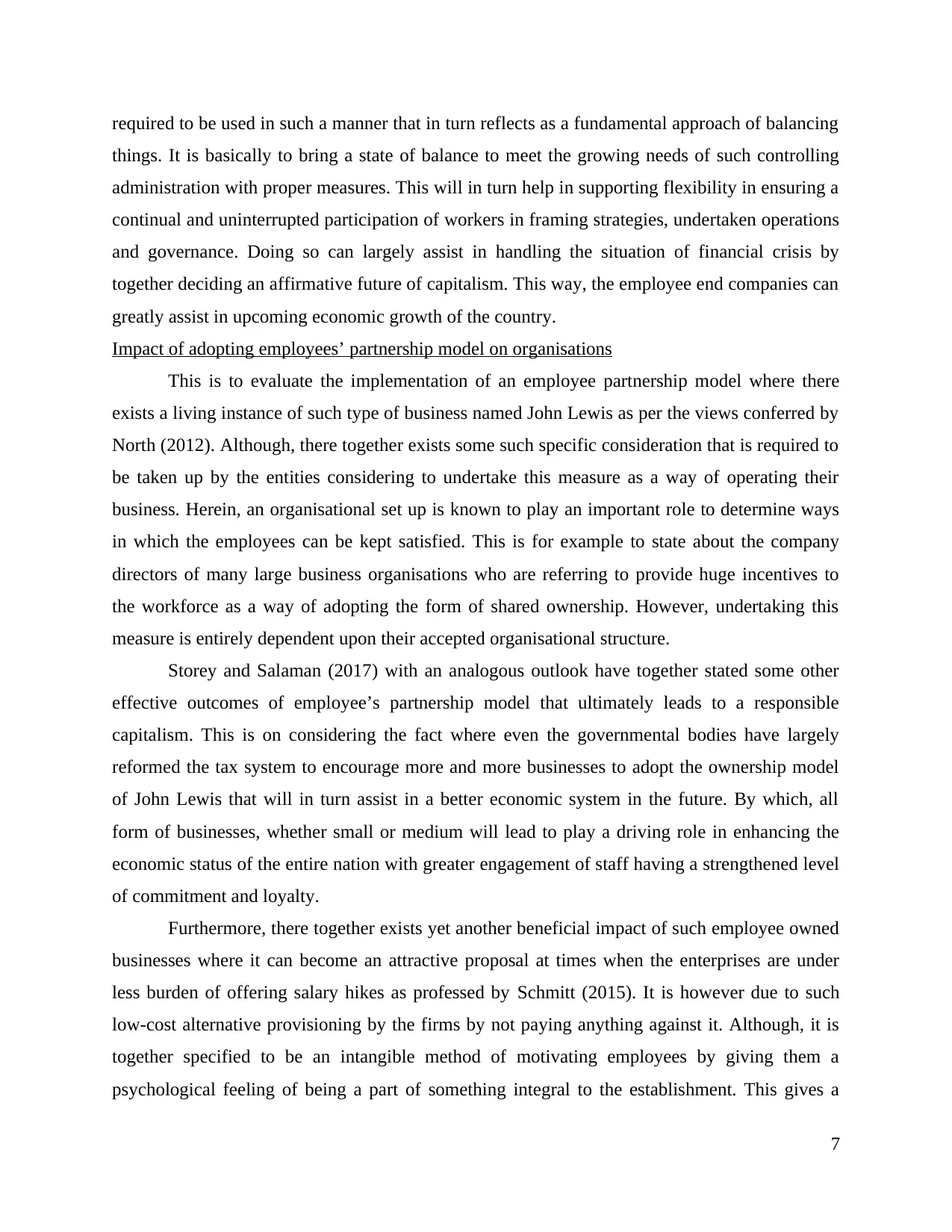
required to be used in such a manner that in turn reflects as a fundamental approach of balancing
things. It is basically to bring a state of balance to meet the growing needs of such controlling
administration with proper measures. This will in turn help in supporting flexibility in ensuring a
continual and uninterrupted participation of workers in framing strategies, undertaken operations
and governance. Doing so can largely assist in handling the situation of financial crisis by
together deciding an affirmative future of capitalism. This way, the employee end companies can
greatly assist in upcoming economic growth of the country.
Impact of adopting employees’ partnership model on organisations
This is to evaluate the implementation of an employee partnership model where there
exists a living instance of such type of business named John Lewis as per the views conferred by
North (2012). Although, there together exists some such specific consideration that is required to
be taken up by the entities considering to undertake this measure as a way of operating their
business. Herein, an organisational set up is known to play an important role to determine ways
in which the employees can be kept satisfied. This is for example to state about the company
directors of many large business organisations who are referring to provide huge incentives to
the workforce as a way of adopting the form of shared ownership. However, undertaking this
measure is entirely dependent upon their accepted organisational structure.
Storey and Salaman (2017) with an analogous outlook have together stated some other
effective outcomes of employee’s partnership model that ultimately leads to a responsible
capitalism. This is on considering the fact where even the governmental bodies have largely
reformed the tax system to encourage more and more businesses to adopt the ownership model
of John Lewis that will in turn assist in a better economic system in the future. By which, all
form of businesses, whether small or medium will lead to play a driving role in enhancing the
economic status of the entire nation with greater engagement of staff having a strengthened level
of commitment and loyalty.
Furthermore, there together exists yet another beneficial impact of such employee owned
businesses where it can become an attractive proposal at times when the enterprises are under
less burden of offering salary hikes as professed by Schmitt (2015). It is however due to such
low-cost alternative provisioning by the firms by not paying anything against it. Although, it is
together specified to be an intangible method of motivating employees by giving them a
psychological feeling of being a part of something integral to the establishment. This gives a
7
things. It is basically to bring a state of balance to meet the growing needs of such controlling
administration with proper measures. This will in turn help in supporting flexibility in ensuring a
continual and uninterrupted participation of workers in framing strategies, undertaken operations
and governance. Doing so can largely assist in handling the situation of financial crisis by
together deciding an affirmative future of capitalism. This way, the employee end companies can
greatly assist in upcoming economic growth of the country.
Impact of adopting employees’ partnership model on organisations
This is to evaluate the implementation of an employee partnership model where there
exists a living instance of such type of business named John Lewis as per the views conferred by
North (2012). Although, there together exists some such specific consideration that is required to
be taken up by the entities considering to undertake this measure as a way of operating their
business. Herein, an organisational set up is known to play an important role to determine ways
in which the employees can be kept satisfied. This is for example to state about the company
directors of many large business organisations who are referring to provide huge incentives to
the workforce as a way of adopting the form of shared ownership. However, undertaking this
measure is entirely dependent upon their accepted organisational structure.
Storey and Salaman (2017) with an analogous outlook have together stated some other
effective outcomes of employee’s partnership model that ultimately leads to a responsible
capitalism. This is on considering the fact where even the governmental bodies have largely
reformed the tax system to encourage more and more businesses to adopt the ownership model
of John Lewis that will in turn assist in a better economic system in the future. By which, all
form of businesses, whether small or medium will lead to play a driving role in enhancing the
economic status of the entire nation with greater engagement of staff having a strengthened level
of commitment and loyalty.
Furthermore, there together exists yet another beneficial impact of such employee owned
businesses where it can become an attractive proposal at times when the enterprises are under
less burden of offering salary hikes as professed by Schmitt (2015). It is however due to such
low-cost alternative provisioning by the firms by not paying anything against it. Although, it is
together specified to be an intangible method of motivating employees by giving them a
psychological feeling of being a part of something integral to the establishment. This gives a
7

substantial option to the individuals of exercising their share alternatives where they can either
purchase shares or directly consider selling them by not using their own funds. Here, the buying
price is counterbalance against the profits received from sale.
8
purchase shares or directly consider selling them by not using their own funds. Here, the buying
price is counterbalance against the profits received from sale.
8
⊘ This is a preview!⊘
Do you want full access?
Subscribe today to unlock all pages.

Trusted by 1+ million students worldwide
1 out of 30
Related Documents
Your All-in-One AI-Powered Toolkit for Academic Success.
+13062052269
info@desklib.com
Available 24*7 on WhatsApp / Email
![[object Object]](/_next/static/media/star-bottom.7253800d.svg)
Unlock your academic potential
Copyright © 2020–2025 A2Z Services. All Rights Reserved. Developed and managed by ZUCOL.





